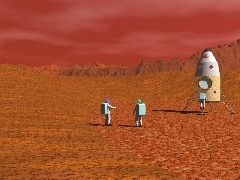
 |
|||||||
|
|
|
|
|
|
|
|
|
|
Sub-Orbital |
Orbital |
LEO Station |
Mission Statement |
Lunar Orbit |
Lunar Surface |
Mars and Beyond |
An expedition to Mars is a
major goal of Universal Expeditions. Travel to the Red Planet and back
is not a trivial undertaking, but with the incremental approach outlined in
these pages, the first Expedition to Mars could occur as early as the 2016
launch window. Using extensions of the equipment that allowed
Expeditions to earth orbit and the moon, the initial Martian Expedition would
send three people on a 3 year mission to Mars and back.
This initial mission would consist of three elements: a Mars Transfer Vehicle based on LEO station modules that would carry the crew to and from Mars, a Mars Hab based on lunar base modules that would support a fifteen month occupation of Mars, and a Universal Lander based on the lunar lander, but with a reentry aeroshell and improved life support systems, that would transfer the crew to the surface and back to orbit. Liquid hydrogen/LOX propellant boosters would launch the elements on Hohmann transfer orbits to Mars. The initial mass of the entire Expedition, including propellant would be 210-220 mt, or eleven MOV launches. This mission would not utilize in-situ fuel generation.
Upon arrival at Mars, the three elements would aero-brake into Mars orbit and the Hab would descend to the landing zone. Even if the Hab failed to survive, the crew could still perform a short Martian surface excursion in the Lander. At the end of the surface expedition, the Lander would return the crew to the orbiting Transfer Vehicle which would fire the methane-fueled return engine module to achieve a Hohmann transfer orbit back to earth, arriving 980 days after launch.
The elements of this mission provide a vehicle suitable for interplanetary missions to the inner planets and asteroids, a lander capable of operating on Mars and every moon in the solar system and a base capable of long duration occupation.
Note: If Expedition planners had great confidence in the success of in-situ fuel generation, a single integrated vehicle could accomplish the above mission with only 105 mt, or five fully loaded MOV launches, but such an Expedition would require a direct Mars landing, and no return until enough fuel could be generated on the Martian surface.
All pages and images ©1999 - 2005
by Geir Lanesskog, All Right Reserved
Usage Policy
![]()